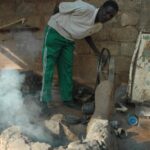In Burkina Faso traditional stirrups come in various different forms – rounded or flattened, larger or smaller – and horsemen of old used to have a selection of different stirrups for use on different occasions, whether visiting a friend, attending a wedding or going on a long journey.
Traditionally stirrups were made out of iron but these days the metal of choice is bronze.
We documented the work of a blacksmith in Kaya (central Burkina Faso). Roger Bamogo is a 41 year-old Mossi man who learned the trade from his father. He has a workshop in the grounds of the Kaya Museum. Here he makes bronze statuettes, axe-heads and stirrups. The lost wax casting technique that he uses can also be used to make bracelets and buckles and is something we are exploring for the production of belts and bag components.
Roger works quickly and intuitively, with only the simplest of tools. He boasts that he could make a pair of stirrups blindfold from start to finish. His catchphrase, uttered in French at frequent intervals, is this: “Etre forgeron, il faut etre fort” (to be a blacksmith you need to be strong). His favourite joke: “What do you call a lazy blacksmith? A jeweller!”
To make a pair of bronze stirrups, a lump of beeswax is softened in the sun or over a low fire (Image 1). The soft wax is rolled by hand on a wooden board to make a long wax sausage which is then fashioned into the desired stirrup shape (Image 2).
Reddish laterite clay and donkey dung are ground with a pestle (moore word – zaaré) and mixed with a little water. The dung is a strengthening agent – any mould made from pure clay would break in the fire. The clay/dung mixture is plastered all over the beeswax stirrup, leaving a small hole at the top and a thimble-shaped ‘neck’ for pouring (Image 3).
The mould is leant against a small fire so that the wax melts (main image). It is taken off three or four times and wax is poured out (and saved for future use)
A teacup-sized crucible is filled with scrap bronze (Image 4) and placed into the middle of the blacksmith’s furnace, surrounded by red-hot coals. The mould is placed on top of the coals because that also needs to be hot. The bellows are pumped vigorously to keep the temperature as high as possible. Most blacksmiths use goatskin bellows, but Roger has made his own labour-saving system out of a bicycle wheel and a length of metal tubing. (Image 5)
Within half an hour the smoke from the crucible changes colour from grey to greenish white, indicating that the bronze has melted. The molten metal is poured into the empty mould (Image 6), and will set hard within fifteen minutes. Then the clay mould is broken (Image 7), the thimble-shaped neck is snapped off and the stirrup is filed until it shines (Image 8).










Fantastic. What is the ratio of clay to dung? What is the mix the crucible is made of?
Glad you like the post! I spoke to Amidou who made the bronze buckles in the video (see our post on 17 October 2013) to find out the answers to your questions. He doesn’t know the exact percentage, he goes by the feel of it. But it is mostly clay, about 90% he reckons. The crucible is traditionally made of clay too, which is what Roger used in the making of the stirrups in this post, but Amidou sometimes uses an iron pot which has a higher melting temperature than the bronze.